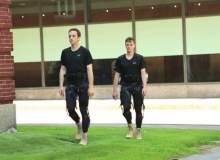

Discover B2B Marketing That Performs
Combine business intelligence and editorial excellence to reach engaged professionals across 36 leading media platforms.
The Wyss Institute at Harvard University has received a $2.9m contract from DARPA to develop its one-of-a-kind device, known as the ‘Soft Exosuit’. Instead of huge and bulky metal frames – like the ones seen in Hollywood blockbusters – which can actually limit natural movement, the Harvard-developed suit uses textiles woven together meaning it can be pulled on like a normal pair of trousers.
"While the idea of a wearable robot is not new, our design approach certainly is," said Conor Walsh, a core faculty member at the Wyss Institute. "At Harvard we are studying the biomechanics and physiology of human walking, trying to understand what makes that such an efficient process."
"We then apply this knowledge to the design of soft wearable robots that act in parallel with the body’s muscles and tendons and mimic their function," adds Walsh, who is also the founder of the Harvard Biodesign Lab.

US Tariffs are shifting - will you react or anticipate?
Don’t let policy changes catch you off guard. Stay proactive with real-time data and expert analysis.
By GlobalDataThe funding from DARPA is part of a programme called Warrior Web which is exploring new technologies to reduce loads on soldiers and in turn lower the chances of musculoskeletal injuries.
Exosuits utilise precision over power
Rather than giving the wearer Incredible Hulk levels of strength, the suit provides small but carefully timed assistance at the joints. In its current form, the suit consists of a series of webbing straps positioned on the lower body which contain a low-power microprocessor and a network of soft sensors. Combined these provide the "brain" and "nervous system" of the Soft Exosuit.
Impressive footage of advanced designs in action make robots look battlefield ready, so why haven’t they been deployed yet?
The suit, made from nylon, polyester and spandex, is strapped to the user’s hips and thighs and connects to boots at the heel. The soft sensors track the user’s gait and sends signals to an actuator box on the user’s waist or backpack, which in turn tugs on cables strapped at the hips and ankles to give well-timed bursts of power and reducing the energy needed for tasks like walking, running or sprinting.
Unlike the power-hungry rigid exoskeletons, Harvard’s textile variant runs on around 50 watts of continuous power and can operate for four hours. The suit, actuator and battery weigh around six kilograms (13 pounds) altogether and are mostly carried around the waist area. A key question for the US military is whether carrying an extra six kilograms is offset by the energy saved through using the device.
Harvard’s lightweight suit represents a significant shift away from the industry norm of developing heavy exoskeletons, like Lockheed Martin’s Human Universal Load Carrier, which weighs around 24kg. Could the Soft Exosuit be the future of assisted load-carrying?
Follow Grant Turnbull on Google+


.gif)



